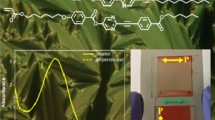Abstract
The mean square tilt angle of a nematic slab with finite anchoring energy and periodic boundary conditions has been theoretically investigated, as a function of the slab geometry and of the reduced extrapolation length. If the anchoring strength is free-surfacelike, the contrast is affected by a loss ≳10% at room temperature if the ratio between the anchoring pitch and the cell thickness is ≳0.5.
Similar content being viewed by others
Abbreviations
- λ :
-
anchoring pitch
- h :
-
cell thickness
- Λ :
-
λ/h
- (ξ = x/λ, η = y/h):
-
reduced coordinates
- ϑ(ξ, η) :
-
local tilt angle
- κ :
-
elastic constant
- wa :
-
anchoring energy anisotropy
- b=κ/w a :
-
de Gennes-Kleman extrapolation length
- B=b/h :
-
reduced extrapolation length
- T NI :
-
nematic-isotropic transition temperature
- τ:=(T/T NI ) − 1:
-
reduced temperature
- Φ :
-
easy axis direction
- α :
-
Φ MAX
- 〈ϑ 2± 〉:
-
mean square tilt angle along the boundary
- α∥(α⊥):
-
absorbance coefficients of the p-dye
- r :
-
α∥/α⊥: dichroic ratio
- c :
-
contrast
- G :
-
contrast gain
- S :
-
order parameter
References
J.F. Clerc, J.C. Deutsch, F. Vinet: In GNCLCristalli Liquidi, Proc. UNICAL 81 (CLUT, Torino 1982) p. 793
R.A. Soref, M.J. Rafuse: J. Appl. Phys.43, 2029 (1972)
Such a well known effect occurs when an electric field of sufficient intensity is applied on a homeotropic nematic cell characterized by a negative dielectric anisotropy (Nn-liquid crystal)
S. Matsumoto, M. Kawamoto, K. Mizunoya: J. Appl. Phys.47, 842 (1976)
A guest-host interaction is obtained, by doping a liquid crystal with a dichroic compound characterized by long molecules, able to be reoriented along the NLC director
T. Uchida, H. Seki, C. Shishido, M. Wada: Mol. Cryst. Liq. Cryst.54, 161 (1979)
R.J. Cox: Mol. Cryst. Liq. Cryst.55, 1 (1979)
T. Uchida, M. Wada: Mol. Cryst. Liq. Cryst.63, 19 (1981)
M. Schadt, P. Gerber: Mol. Cryst. Liq. Cryst.65, 241 (1981)
A. Strigazzi: In GNCLCristalli Liquidi, Proc. UNICAL 81 (CLUT, Torino 1982) p. 43
D.W. Berreman: Mol. Cryst. Liq. Cryst.23, 215 (1974)
N. Nakamura, M. Ura: J. Appl. Phys.52, 211 (1981)
D.C. Flanders, D.C. Sharer, H.T. Smith: Appl. Phys. Lett.32, 597 (1978)
G. Barbero: Lett. Nuovo Cimento29, 553 (1980)
W.R. Heffner, D.W. Berreman, M. Sammon, S. Meiboom: Appl. Phys. Lett.36, 144 (1980)
O. Auciello: J. Vac. Sci. Technol.19, 841 (1981)
G. Barbero: Lett. Nuovo Cimento32, 60 (1981)
A. Strigazzi, G. Barbero, E. Miraldi, C. Ferrero: Mol. Cryst. Liq. Cryst. Lett. (1983) (to be published)
M. Kleman:Point Lignes Parois (Les Ed. de Physique, Paris 1977)
P.G. de Gennes:Physics of Liquid Crystals (Clarendon Press, Oxford 1974)
G. Barbero, A. Strigazzi: Nuovo Cimento64B, 101 (1981)
S. Naemura: Appl. Phys. Lett.33, 1 (1978)
D.W. Berreman: J. Phys. C (Paris)3, 58 (1979)
A dichroic dye is called as a positive type dye if its transition moment is almost parallel to its molecular axis
M.A. Bouchiat, D. Langevin-Cruchon: Phys. Lett.34A, 331 (1971)
H. Kelker, R. Hatz,Handbook of Liquid Crystals (Verlag Chemie, Weinheim 1980) p. 272
S. Jen, N.A. Clark, P.S. Pershan, E.B. Priestley: Phys. Rev. Lett.31, 1552 (1973)
Author information
Authors and Affiliations
Rights and permissions
About this article
Cite this article
Barbero, G., Strigazzi, A. The contrast gain in a guest-host nematic display due to a periodic boundary condition. Appl. Phys. A 31, 55–57 (1983). https://doi.org/10.1007/BF00617189
Received:
Accepted:
Issue Date:
DOI: https://doi.org/10.1007/BF00617189




